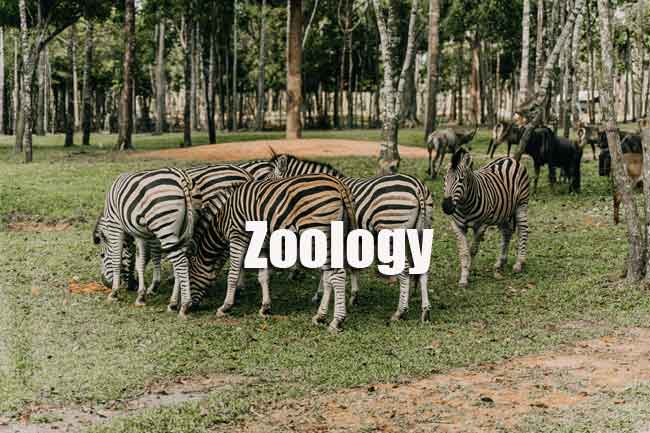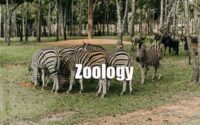NET JRF Zoology Question
In this Article, we have provided the NET JRF Zoology Question Papers along with Solutions. So, the interested candidates who applied for jobs in NET JRF Zoology can download NET JRF Zoology Question Papers for free of cost. Get all the NET JRF Zoology Question Papers with just one click. Click on the enclosed links below to download the NET JRF Zoology Question Papers.

Check the Last five years NET JRF Zoology Question Papers to get a clear idea of the exam pattern. Along with NET JRF Zoology Question Papers, it’s better to refer NET JRF Zoology Syllabus & Exam Pattern before starting preparation. So, click on link to check and download NET JRF Zoology Question Papers PDF.
Question Papers of NET JRF Zoology
1. Fluctuation in the distribution of gene frequencies caused by isolation of non-representative samples of the founding population is called
(1) Genome
(2) Genotype
(3) Genetic drift
(4) Gene pool
2. Phenomenon of Industrial melanism in Biston betularia demonstrate
(1) Evolution
(2) Mutation
(3) Directional Natural Selection
(4) Stabilizing Selection
3. Evolution of Homo sapiens occurred in :
(1) Oligocene
(2) Miocene
(3) Pleistocene
(4) Eocene
4. Under Territorial behaviour, Wilson (1975) classified territories into various types. What is Type-B territory ?
(1) Area for resting and mating
(2) Area for nesting and feeding
(3) Area for mating and nesting
(4) Area for resting and feeding only
5. Quick response towards stress is because of .
(1) Androgen
(2) Epinephrine
(3) Corticosteroids
(4) Estrogen
6. In lesion experiment to study eating behaviour, which part of hypothalamus was found as satiety centre ?
(1) Ventro-medial
(2) Dorsal
(3) Lateral
(4) Anterior
7. In biological clock, ‘circadian rhythm’ is term used for
(1) 12hrs
(2) 12 days
(3) 24 days
(4) 24hrs
8. Biological clocks which are synchronized with the moon phases are called
(1) circasynodic clocks
(2) semilunar clocks
(3) circadian clocks
(4) circatidal clocks
9. Which bird travel longest distance during migration ?
(1) Arctic tern
(2) Mallard
(3) Himalayan geese
(4) Night hawk
10. Fish migrates from sea to fresh water and from fresh water to sea but not for breeding are called
(1) Amphidromous fish
(2) Potamodromous fish
(3) Diagamous fish
(4) Oceanodromous fish
11. The type of orientation where the rate of change of direction increases in proportion to the increase in light intensity is called —
(1) Klinokinesis
(2) Orthokinesis
(3) Tropotaxis
(4) Telotaxis
12. When honey bee discovers a food source less than 250 feet away from the hive, it pass on the information to other bees by performing
(1) Waggle dance
(2) Round dance
(3) Abdominal dance
(4) Tail dance
13. According to Heape (1961), which of the following is not a primary reason for fish migration ?
(1) Gametic
(2) Alimental
(3) Climatic
(4) Osmoregulatory
14. The scientist associated with classical conditioning :
(1) J. Romanes
(2) Konard Lorenz
(3) Ivan P. Pavlov
(4) Niko Tinbergen
15. Which type of waves. Are produced from parietal and occipital loses when a man is at rest and with eyes closed ?
(1) Alpha waves
(2) Beta waves
(3) Theta waves
(4) Delta waves
16. When an animal retraces its path to the point where it started from, it is called —
(1) Strato orientation
(2) Zonal orientation
(3) Topographic orientation
(4) Positional orientation
17. Eisenberg (1965) proposed four properties of organised societies. Which of the following is not proposed by him ?
(1) Communication
(2) Cohesion
(3) Division of Labour
(4) Impermanence and Permeability
18. Mermaid’s purse is related to which of the following fish ?
(1) Scoliodon
(2) Scyllium
(3) Hippocampus
(4) Syngnathus
19. Ethologist S. Grossman (1966) discovered a method of activating, eating and drinking circuits in human brain separately. He used which of the following neuro-inhibitors for this ?
(1) Nor-adrenaline
(2) Methylphenethylamine
(3) Crocaine
(4) Dopamine
20. Which chemical trigger’s drinking behaviour when administered in hypothalamus of rat ?
(1) Acetyl choline
(2) Estrogen
(3) Nor-adrenaline
(4) Dopamine
| Hard Questions | GK |
| Easy Questions | Quiz |
| Important Questions | Viva |
| TRB | MCQs |
| GATE | Sample Papers |
| JRF | Model Questions |
| NEET | Previous Papers |
| Objective |
21. Which of the following is associated with speech in the brain ?
(1) Broca’s area
(2) Right temporal lobe
(3) Hypothalamus
(4) Pituitary gland
22. Promiscuous mating occurs in
(1) Geese
(2) Chimpanzees
(3) Gibbon
(4) Eagle
23. Carolus Linnaeus system of nomenclature is
(1) Natural
(2) Artificial
(3) Phylogenetic
(4) binomial
24. The level at which the species are characterised and named, is called :
(1) Alpha taxonomy
(2) Beta taxonomy
(3) Gamma taxonomy
(4) Cladistic taxonomy
25. Which phylum has a true coelom ?
(1) Cnidaria
(2) Mollusca
(3) Annelida
(4) Porifera
26. Horse belongs to which of the following order ?
(1) Perissodactyle
(2) Artiodactyla
(3) Proboscidea
(4) Carnivora
27. Five Kingdom System of Classification suggested by R.H. Whittaker is not based on
(1) presence or absence of a well defined nucleus
(2) mode of production
(3) mode of nutrition
(4) complexity of body organisation
28. Retrogressive metamorphosis occurs in
(1) Hemichordata
(2) Cephalochordata
(3) Urochordata
(4) Vertebrata
29. The vertebrate does not have
(1) epidermal scales
(2) claw
(3) tail
(4) cnidoblast
30. In human; Stapes, Hyoid, Thyroid Cartilage, Tracheal Cartilages are modification of
(1) neural tube
(2) notochordal cells
(3) neural plate
(4) pharyngeal gill slits
31. The adult animal of which phylum is radially symmetrical; but their larva exhibits bilateral symmetry ?
(1) Annelida
(2) Arthropoda
(3) Mollusca
(4) Echinodermata
32. Which of the following is a mismatched pair ?
(1) Scales — Reptalia
(2) Combplates — Mollusca
(3) Choanocytes — Porifera
(4) Parapodia — Annelida
33. Which of the following is an egg laying mammal?
(1) Ornithorhynchus
(2) Didelphys
(3) Sorex
(4) Macropus
34. Which of the following is not a order of class Echinoidia of phylum Echinodermata ?
(1) Cidaroida
(2) Didematoida
(3) Clypeasteroida
(4) Ophiurida
35. Which of the following is not a class of phylum Cnidaria ?
(1) Hydrozoa
(2) Scyphozoa
(3) Trematoda
(4) Anthozoa
36. Biradial symmetry is found in which of the following ?
(1) Hydra
(2) Labeo
(3) Beroe
(4) Sponges
37. The phylum of sea mouse is
(1) Mollusca
(2) Cnidaria
(3) Annelida
(4) Arthropoda
38. Which of the following animal belongs to the phylum mollusca ?
(1) Devil fish
(2) Dog fish
(3) Silver fish
(4) Jelly fish
39. Which one of the following kinds of animals are triploblastic ?
(1) Flatworms
(2) Sponges
(3) Ctenophores
(4) Corals
40. Which of the following is not a deuterostome ?
(1) Sea urchin
(2) Earthworm
(3) Sand dollar
(4) Ichthyophis
41. Taxonomy based on maximum number of phenotypic characters is
(1) Phytogenetic system
(2) Artificial system
(3) Natural system
(4) Sonotaxonomy system
42. According to Affinities of Hemichordata with Echinodermata, following is not a larval resemblance :
(1) Presence of apical plate with gensory hairs, eye spots and telotroch
(2) Small, pelagic, transparent and oval
(3) Enterocoelic origin of coeloms
(4) Blastopore becomes the anus
43. Sipunculus is commonly known as
(1) Peanut worm
(2) Beetle worm
(3) Lug worm
(4) Rag worm
44. Which of the following is not a larva of star fish ?
(1) Dipleurula larva
(2) Bipinnaria larva
(3) Brachiolaria larva
(4) Auricularia larva
45. How many arms are present in Antedon ?
(1) 16
(2) 8
(3) 12
(4) 5

